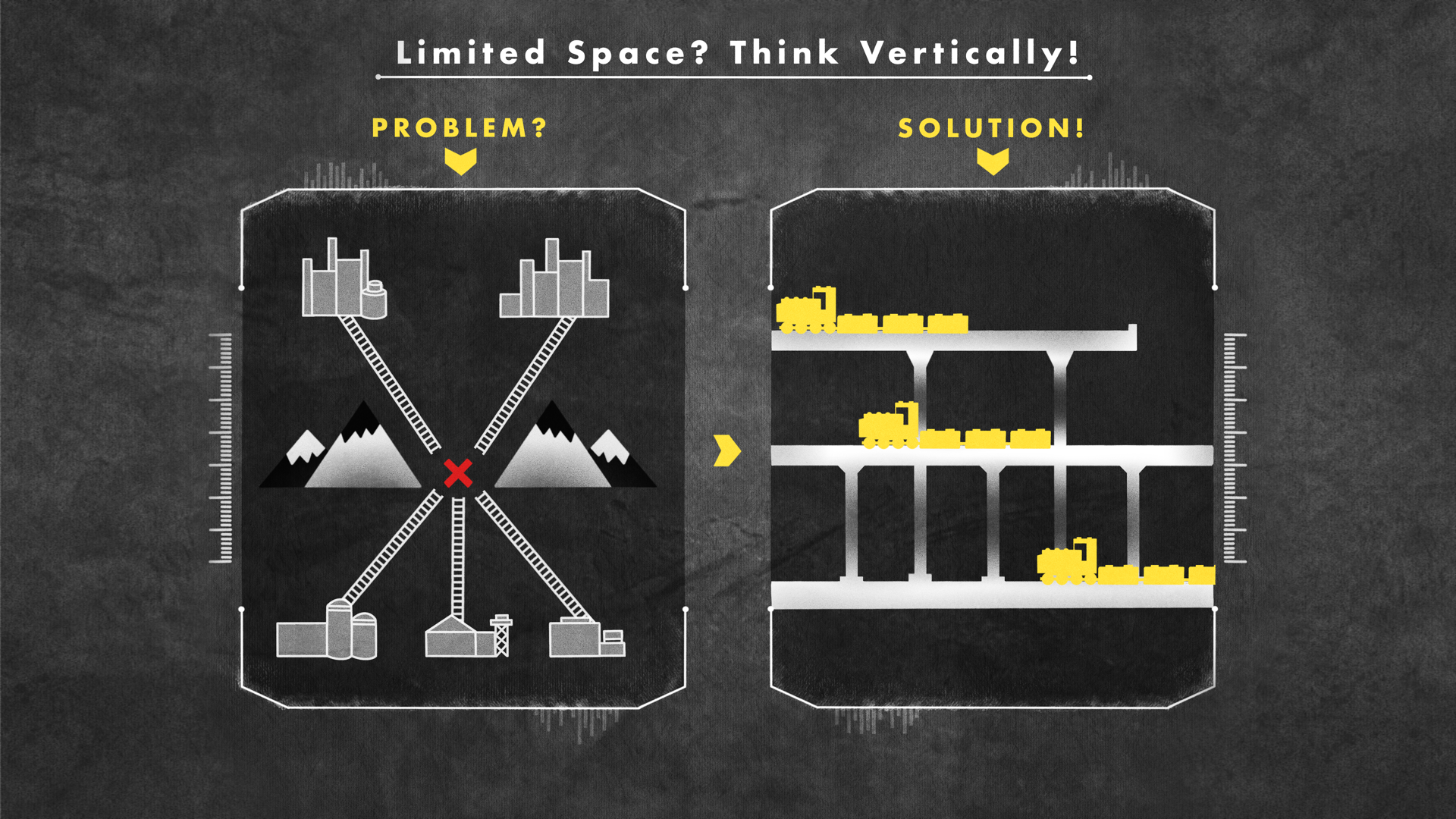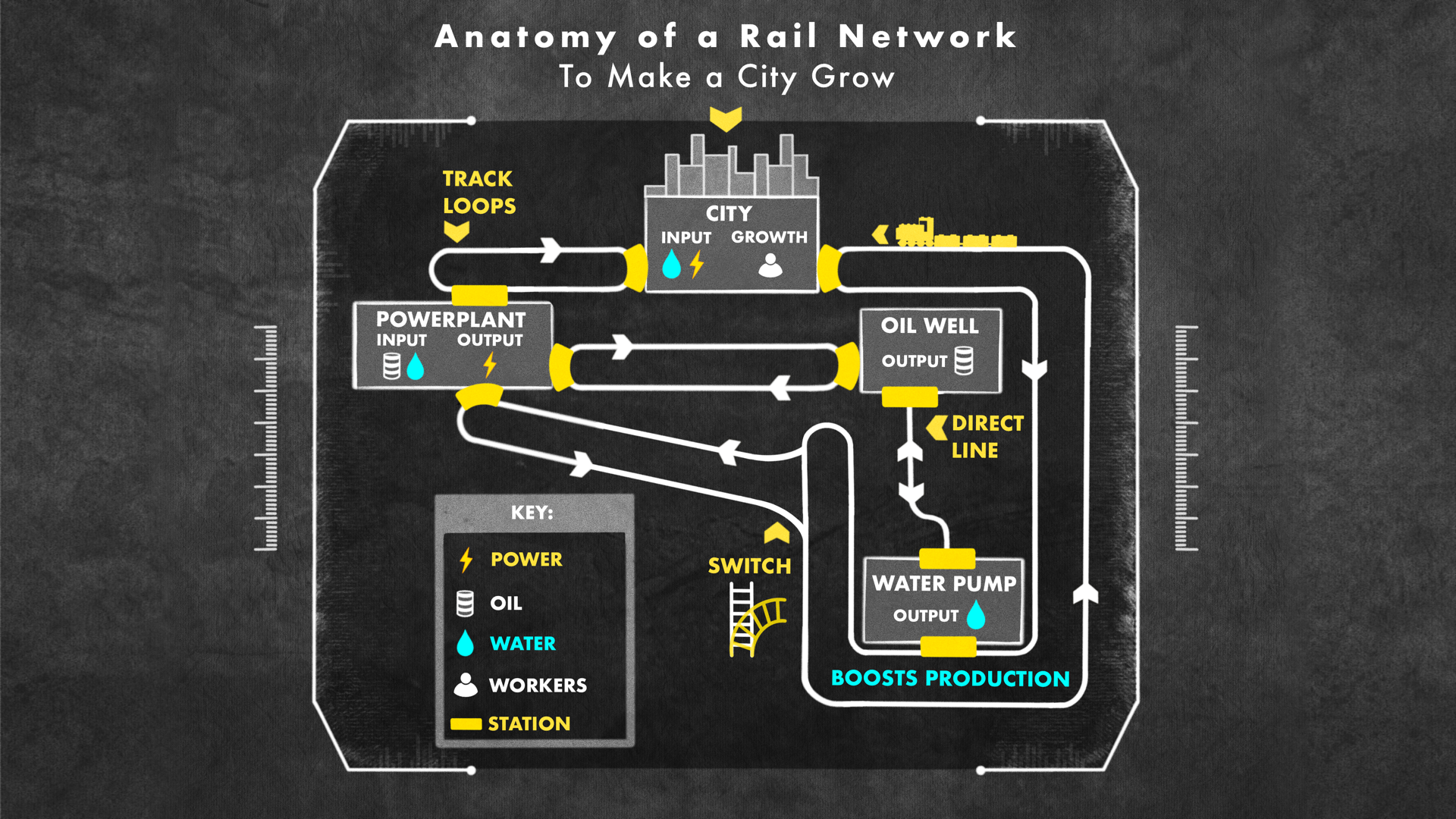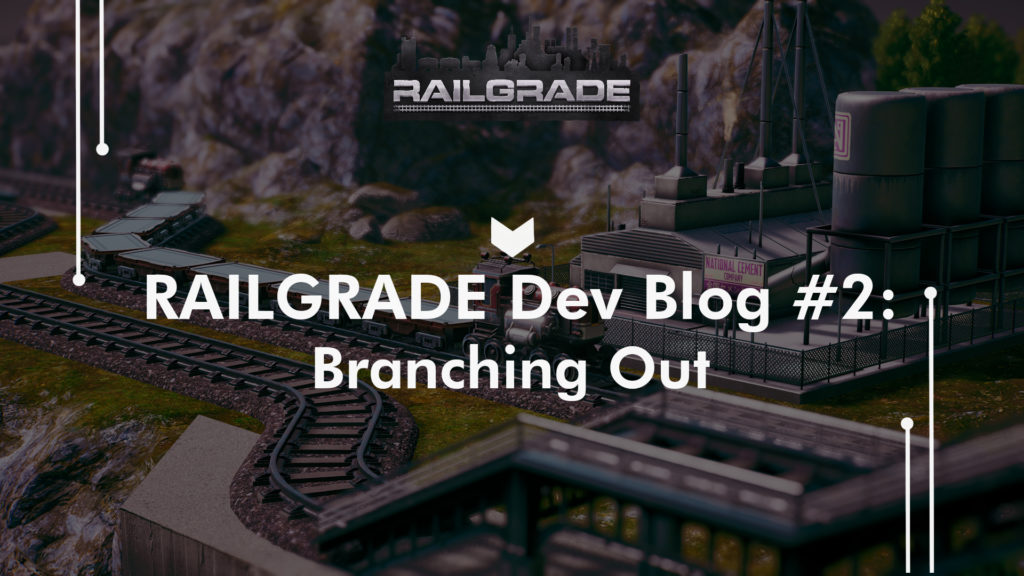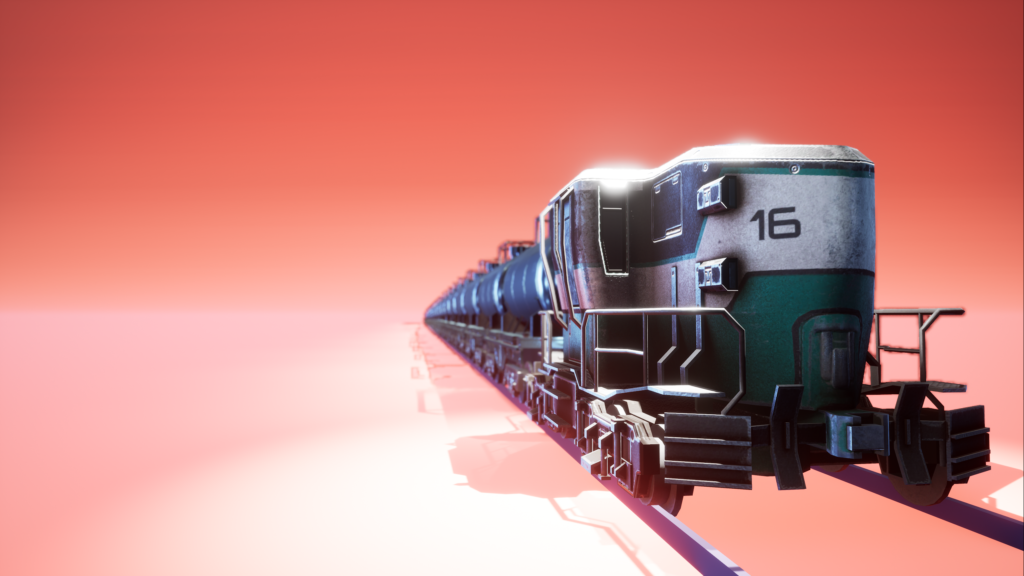Greetings Industrialists!
Today we’re going to be discussing gameplay factors such as verticality and branching! How can you use these concepts to craft your rail networks and what do they bring to the game? Well, hop onboard and we’ll ask the developers.
What aspect of gameplay did you feel was the most important to get right going into creating RAILGRADE?
Jordan: A big aspect was hitting the feeling of emergent complexity. It’s straightforward to build up some basic train routes, but every train or track added becomes a part of the next challenge. As the player works toward their goal, they will find themselves with a large web of trains, rail, and industries. It can be chaotic yet deceptively intuitive to the player who has just finished placing every piece. The big reward is being able to sit back and watch the complexity of the system!
Daniel: Good point on the complexity! For me, I think the progression from simple to complex, building up in layers, was key. The emergent complexity comes from knowing what each bit of track is meant for, then extending that usage. Players need to have a mental model of their track. Then, once we had the complex gameplay nailed, I think we spent a lot of time adding features and polish. This included the train audio simulation or HD Rumble on the Switch. Thus, when players sit down to admire their handy work, there will be a genuine sense of surprise at how complex everything got.
There’s a strong emphasis on Verticality in the game, how important was it for you to open up this dimension of gameplay?
Daniel: If you’ve played Portal with the developer commentary, you might remember a point where they comment on how hard it is to get players to look up. I think in general, video games avoid requiring vertical gameplay because as humans we just do not look up! For RAILGRADE, I knew introducing true vertical gameplay would be an uphill battle, but Jordan insisted.
Jordan: Verticality was a core theme I wanted to explore, going back to the earliest prototypes. I often found vertical construction to be an unexplored or underutilized aspect of building games, though I greatly enjoyed it when it was possible. I wanted to see what would happen if vertical expansion was the rule instead of the exception, a landscape of trains and rail spanning many heights. This brought up several design challenges around letting the player intuitively build and interact with the multi-dimensional train networks and the controls went through many iterations. In the end, the verticality contributes heavily to RAILGRADE’s unique visuals and gameplay.
Daniel: Not just design challenges, but technical ones too! Chris spent many months creating systems and optimizations to make the extreme buildability function. I remember at one point, our benchmark map had 72,000 draw calls and ran at 15fps. Chris got that down to 3,000 draw calls at 60fps.

Terrain can affect how a level plays out in RAILGRADE. How did you approach crafting levels that can restrict space but still allow for creativity?
Jordan: Our missions are designed to be played any number of ways. We found early on that trying to create scenarios with a puzzle-like ‘one true solution’ was not something we wanted. Maps can vary from rolling plains to tight canyons and steep mountains. While the terrain features can act as obstacles, they also present interesting decisions. When traversing a valley for example, a player could design a cheaper but longer route through the basin or find a good spot for a direct, expensive bridge. Players can take advantage of downhill slopes when trains are heavy with freight and find more gradual slopes when hauling uphill. The terrain can provide as many opportunities as it does limitations.
Of course, as your funds increase throughout a mission you may find the terrain falls away as the main obstacle, compared to expanding your own infrastructure. After all, even the steepest cliffs can be bested by a few thousand tons of steel and concrete if you have the money!
Daniel: In addition, as I know a couple players will ask, we did not implement terrain terraforming. This was to keep the region’s terrain’s impact on gameplay. As a game designer, a common challenge with terraforming is that players can use said feature to flatten the land and make all maps play the same. Instead, we wanted players to invest into conquering the terrain through verticality and giant rail viaducts.
What did the addition of branching bring to the game? Branching is something that the community is quite excited about!
Jordan: Early on we were experimenting with a branchless rail system. Track could be built as simple lines or loops, but could not fork or join other track. This did encourage players to build many interweaving railways which was a big design goal. However, in the end, we found it just limited the player’s toolset. After implementing the ability to branch, many new possibilities opened up: multilane stations, alternating routes, sub-networks feeding into mainlines, etc. Designing track and trains became much more engaging and, with the new tools, the rail networks tended to become even more visually interesting and complex! However, branching did introduce the question of how trains would choose which paths to take. We needed a system of routing that would not become cumbersome with the amount of trains and stations the player would be building. We went with a train-centric approach. Each train has its own path, which is visualized on the world while selected. The player can modify the train’s route in real time simply by clicking on branch switches along the map. Any new trains cloned from this train also keep the same configuration, saving time when building up routes. We think this system hits the sweet spot of fine tuned control, while still keeping it quick and enjoyable to use.

Why was it important to the team to have a deep variety of industrial chains in the game?
Jordan: You can’t have trains without places for them to go. We wanted a lot of variety in the industries, both visually and in function. While some industries are part of a deep chain of industry, others can be simpler but process a high volume of resources needed for cities. Others may produce byproducts that need to be disposed of. This, combined with the raw resources available, can keep the challenge fresh while always giving a reason to keep the rail network growing.
The ‘catalyst’ system also benefits from a breadth of industries, as each industry’s production speed can be boosted up by delivering catalysts. This allows players to further optimize their existing production, if your trains can keep up!.
Chris: At its core, RAILGRADE is about optimizing logistics. For this to be an interesting challenge, it needs to have several dimensions of complexity. I think in RAILGRADE the most obvious level of complexity is the terrain and usage of the vertical dimension. Other aspects which add to the complexity are; production speed manipulation through worker distribution, upgrades and catalysts, as well as train configuration, allowing players to assemble the ideal combination of engines and cargo. In this context, extensive industrial chains add another important level of depth to the logistics, since it’s more challenging to balance long production chains.
The dimensions of complexity also amplify each other. Terrain becomes a more interesting challenge if you not only have to connect a bunch of industries from A to B, but also have to consider how products from B can then be transported to C and D. The depth of industrial chains also increases the challenge of managing the individual production speeds of all factories in a chain for optimal throughput and configuring all the trains that run between factories, keeping the optimization game going.
Do you feel RAILGRADE works for players who will want to get into every intricacy of the game and those players who want a more relaxed, train set experience?
Daniel: Not only do I think challenge seeking players and relaxation seeking players can find what they want in RAILGRADE; I know it! During my own play, my mood switches between the two modes. Sometimes I’ll start a region low key, building bit by bit and not caring about the timer or expecting to get a grand result. As I build up my region I start getting a bit more serious. At times, I might stay low key or other time’s I’ll start hardcore, planning a dense network from the start. Then, once I achieve my goal, I just ride trains around and around. RAILGRADE lets you play to match your mood.
Chris: When I joined development, RAILGRADE’s terrain consisted of rectangular gray blocks and a few plastic trees. One of my main tasks has been making RAILGRADE’s environment look a bit more interesting. To that end, I developed a terrain system and used it to design five different climates with individual geological properties and foliage. Where I grew up, I often visited a huge RC and model fair which was held every year close to my hometown. I was glad that our game designer Daniel had decided on a realistic style for RAILGRADE, so I could try to recreate properties of the model train dioramas that always fascinated me. In RAILGRADE, you can virtually ride trains to experience the environment on their route from their perspective, which is pretty relaxing. You can even try to find the deer running around in some climates!
Are you looking forward to seeing how players build their networks once the game goes live on September 29th?
Daniel: Oh, yes indeed! I expect players will find super unique play styles. We implemented the photo mode for easy screenshotting, so players can show off their towering creations!
https://youtu.be/hOql6VT1QNU
That’s all for this month’s installment of RAILGRADE’s dev blog! We’re eager to see what you’ll make of your railway networks. Don’t forget to keep yourself up to date with all things RAILGRADE on our Twitter and Discord.
RAILGRADE arrives September 29th on PC via the Epic Games Store and the Nintendo Switch via the eShop for 10% off until October 6th. Wishlist today!
Until next time, keep good time, Industrialists.


